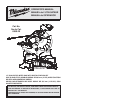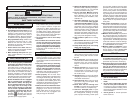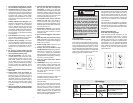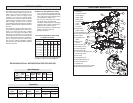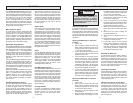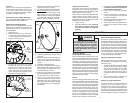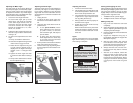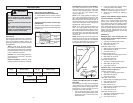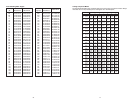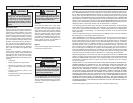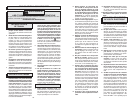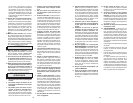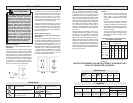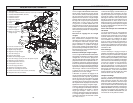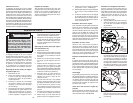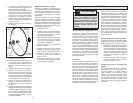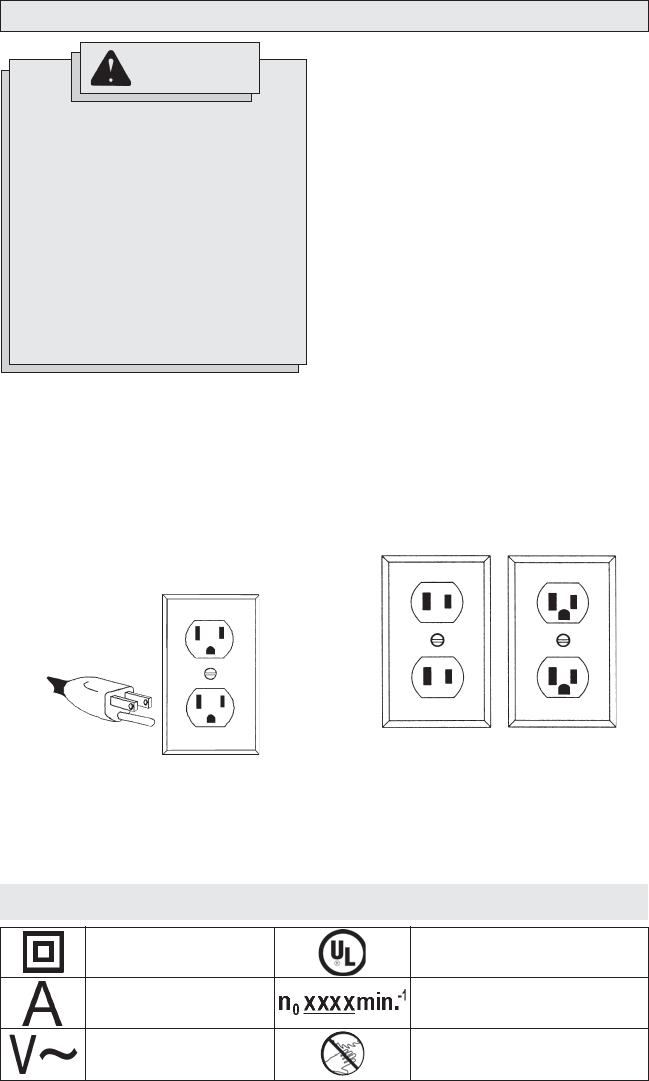
4 5
5. Do not defeat the guards or operate
the tool without the guards in place.
6. Avoid kick back. Kick back is a violent
reaction to a pinched or binding blade,
which throws the saw head upward and
towards the operator. Proper workpiece
selection and support, proper blade
selection and maintenance, and even
feed rate are essential to reduce the risk
of kick back.
7. Always support work properly. Use
the fence, support blocks, auxiliary work
support or clamps to keep workpiece
secure. Always support the free end
of the workpiece and support all small
workpieces. Workpieces that bow and
pinch the blade may result in kick back.
Do not perform any operations freehand
(unsupported).
8. Thin material tends to warp or sag and
must be well-supported over its entire
length to avoid pinching the blade.
9. Position fence properly. The fence
can be adjusted for compound cuts and
miter cuts. Always make sure the fence
is adjusted for the intended cut. Never
operate the saw without the fence in
place.
10. Be sure the clamp handle and the
bevel adjustment lever are tightened
securely before making cuts.
11. Use the right blade. Use only recom-
mended blade types and sizes with
proper mounting holes, rated at least
5500 RPM. Follow the rotation arrow
on the blade to be sure you install it
properly. Keep saw blades sharp to help
prevent cracking and grabbing. Never
use defective or incorrect washers or
bolts.
12. Do not use abrasive wheels with the
miter saw.
13. Keep blades clean and sharp. An
unsharpened or improperly sharpened
blade produces a narrow kerf and is
likely to be pinched by the workpiece. A
dull blade produces excessive friction
which can cause the blade to warp or
bind. Be sure the blade screw is tight
to prevent slipping or loosening during
operation.
14. Wait for the blade to reach full speed
before lowering the saw head to make
a cut.
15. Push the saw through the workpiece.
Do not pull the saw through the
workpiece. To make a cut, raise saw
head and pull it out OVER the workpiece
WITHOUT cutting, start the motor, wait
a few seconds for the blade to reach full
speed, press down on saw head, and
push saw head through the cut.
16. If the blade stalls, do not turn the
switch on and off. A dull blade or
excess pressure may cause stalling.
Release the switch immediately if the
blade binds or the saw stalls and remove
the saw from the cut.
17. Restarting in mid-cut. If you stop the
saw in mid-cut, allow the blade to stop,
then raise the saw out of the cut. Then
restart the saw.
18. Do not lock the trigger in the on posi-
tion.
19. Keep the cord away from the cutting
area and position it so that it will not be
tripped over or caught on the workpiece
while you are cutting.
20. Avoid cutting nails. Inspect for and
remove all nails before cutting.
21. Always wait for the blade to stop
completely before changing positions,
retrieving a cut-off piece, or preparing
the next cut. Unplug the tool before
tightening blade screw, servicing, mak-
ing adjustments, transporting or moving
the saw to another location.
22. Lock the saw head down before
transporting.
23. WARNING: Some dust created by
power sanding, sawing, grinding, drill-
ing, and other construction activities
contains chemicals known to cause
cancer, birth defects or other reproduc-
tive harm. Some examples of these
chemicals are:
• lead from lead-based paint
• crystalline silica from bricks and cement
and other masonry products, and
• arsenic and chromium from chemically-
treated lumber.
Your risk from these exposures varies,
depending on how often you do this
type of work. To reduce your exposure
to these chemicals: work in a well ven-
tilated area, and work with approved
safety equipment, such as those dust
masks that are specifi cally designed to
fi lter out microscopic particles.
The grounding prong in the plug is connected
through the green wire inside the cord to
the grounding system in the tool. The green
wire in the cord must be the only wire con-
nected to the tool's grounding system and
must never be attached to an electrically
“live” terminal.
Your tool must be plugged into an appropri-
ate outlet, properly installed and grounded in
accordance with all codes and ordinances.
The plug and outlet should look like those
in Figure A.
Double Insulated Tools:
Tools with Two Prong Plugs
Tools marked “Double Insulated” do not
require grounding. They have a special
double insulation system which satisfies
OSHA requirements and complies with
the applicable standards of Underwriters
Laboratories, Inc., the Canadian Standard
Association and the National Electrical
Code. Double Insulated tools may be used
in either of the 120 volt outlets shown in
Figures B and C.
Grounded Tools:
Tools with Three Prong Plugs
Tools marked “Grounding Required” have a
three wire cord and three prong grounding
plug. The plug must be connected to a prop-
erly grounded outlet (See Figure A). If the
tool should electrically malfunction or break
down, grounding provides a low resistance
path to carry electricity away from the user,
reducing the risk of electric shock.
Fig. B
Fig. C
Fig. A
Improperly connecting the grounding
wire can result in the risk of electric
shock. Check with a qualifi ed electri-
cian if you are in doubt as to whether
the outlet is properly grounded. Do
not modify the plug provided with
the tool. Never remove the grounding
prong from the plug. Do not use the
tool if the cord or plug is damaged.
If damaged, have it repaired by a
MILWAUKEE service facility before
use. If the plug will not fi t the outlet,
have a proper outlet installed by a
qualifi ed electrician.
GROUNDING
WARNING
Double Insulated
Symbology
No Load Revolutions per
Minute (RPM)
Amperes
Volts Alternating Current
Always keep hands away from
the path of the saw blade.
Underwriters Laboratories, Inc.



